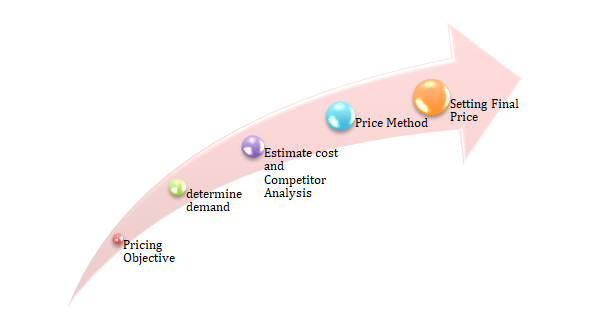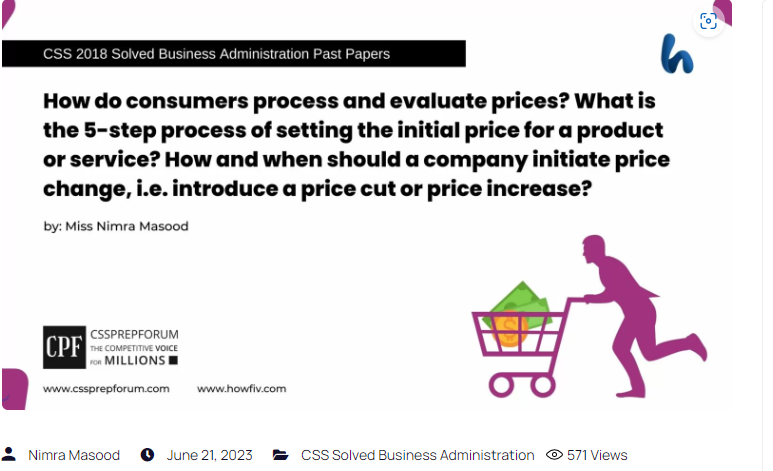CSS Solved Business Administration Past Papers | How do consumers process and evaluate prices? What is the 5-step process of setting the initial price for a product or service? How and when should a company initiate price change, i.e. introduce a price cut or price increase?
The following question is attempted by Miss Nimra Masood, the top scorer in CSS Business Administration papers. Moreover, the answer is written on the same pattern, taught by Sir to his students, scoring the highest marks in compulsory subjects for years. This solved past paper question is uploaded to help aspirants understand how to crack a topic or question, how to write relevantly, what coherence is, and how to include and connect ideas, opinions, and suggestions to score the maximum.

Topic Breakdown:
Business Management is incomplete without an effective marketing strategy; therefore, an in-depth study of marketing concepts is key to scoring a good grade on this paper. Pricing is one part of marketing that can influence the buyer’s decision-making.
Subject: Marketing
Chapter: Pricing
Introduction:
Apart from the features and quality, Marketing is Integral to the success of every product. The whole marketing strategy revolves around product, pricing, placement and promotion. Pricing is integral and technical part of marketing that can determine the fate of a product. It is very crucial to price a product according to the consumer’s perception of its worth. Pricing strategy changes along the product life cycle; several other factors can also determine the shift in pricing policy.
How do consumers process and evaluate prices:
There are various options available to consumers when deciding to buy a product, and a knowledgeable customer is always aware of the competition. The process of evaluating prices and consumer perception revolves around a psychological process. Consumers often process their price information on the basis of past experiences, availability of goods or services and perceived value in comparison to the price.
- Purchase decisions rely on the fact that how a customer perceives pricing, there is a low price threshold below which price consumers perceive the product to be substandard or poor in quality. On the other hand, there is an upper threshold above which the prices are considered prohibitive, and the value is considered less than its price.
- The consumer price perception is based on three factors:
- Price Quality inferences:
Many customers consider price as an indicator of quality. The higher the product is priced, it is deemed to be of higher quality. For e.g., an IPhone is considered to be much higher in quality and hence expensive. On such instances customers are willing to pay the extra amount. However, when information about actual quality is available, price becomes an insignificant factor for quality. - Reference Prices:
When evaluating the price the customers often employ reference price, the amount customer expects to pay actually. It might be different for customers depending upon their interests and need. Relevant indicators like cost, competitor pricing and last purchase can be influential in setting the reference price. - Price Endings:
Many sellers believe prices should end in odd numbers. For e.g. a burger valued at 999 is considered in the range of 900 rather than 1000. Furthermore, prices ending with zero and 5 are also popular and easier for customers to process and associate. Lastly the frequency of sales and its effectiveness of a company are also crucial.
- Price Quality inferences:
Process of setting the initial price for a product:
Whenever a company introduces new product or service, its price is determined by a 5 step process.

Step 1: Setting the Price Objectives:
The first and foremost step in determining the price of a product is to determine its pricing objectives. While for a new company or product with a lot of competitor’s objective could be of survival. The other extreme is to earn maximum profits based on brand name or uniqueness. There are several pricing objectives:
- Market Skimming Pricing:
The objective is to earn maximum revenue in layers from segments willing to pay a high price. The company makes fewer but profitable sales. - Market Penetration Pricing:
The objective is to set a low price in comparison to competitors to attract large number of buyers and; hence, market share. - Survival:
The pricing objective is to recover just enough amount required to cover its cost.
Step 2: Determining the Demand:
There is a direct relationship between the price and demand, the more the monopoly or need, the less volatile the demand. Price elasticity is one tool to assess the sensitivity of demand to changes in price. The relative shift in demand in response to price change is examined by organizations as part pricing strategy. Generally, a rise in price results in reduction of demand, mainly due to shift towards competitors. Demand curves are also used to determine the ideal relationship where company can achieve both high price and considerable demand. Beyond this point the price increase is expected to result in reduction of demand.
Step 3: Estimate Costs and Competitor Analysis:
One crucial factor in determining the price is the costs associated with the product. The foremost objective of businesses is to cover costs and avoid losses. There are two types of costs, Fixed and variable. Companies mostly prefer to achieve economies of scale by producing in bulk and reducing the fixed cost. On the contrary company must analyze the competitors price, its objectives and costs. This analysis will provide opportunity of weakness to cover up and the opportunities to exploit.
Step 4: Pricing Method:
The second last step is to select from a variety of techniques to set a price. There are various types of pricing methods.
- Cost Plus Pricing:
Also known as the mark-up pricing. The company adds a fixed markup to total costs. It is the most simplest and widely used method as costs are almost certain and known. - Target profit Pricing:
Also known as the break-even analysis. The company sets a certain target of profits it wants to achieve; hence adds it to the cost to determine the selling price. - Value-Based Pricing:
The price is based on the customer’s perception of product value rather than the pricing. It is the reverse process, where the company first determines what is expected of the product and what costs would be incurred to deliver that value. - Going Rate Method:
This pricing method is about following the competitors’ pricing instead of the cost or demand. - Auction bid Method:
In this method company bases its price on the expectation of how competitors will price for the product.
Step 5: Setting Final Price:
The final step is a combination of the above four steps based on the competitors, brand value and pricing policy. It is a strategy directed towards achieving the pricing objective.
How and when should a company initiate a price change:
Companies do not keep the price of a product stagnant throughout its life cycle. Internal and external factors may have an influence; therefore, price change is part of the marketing strategy. The company may increase or cut the price of a product according to the situation.
- Initiating Price cuts:
One of the common strategies of price change is a reduction in pricing, either temporary or permanent. Strategies like sales, discounts, and allowances are focused on price reduction. The company may feel the need for price cuts when it desires a rise in sales, react against a fall in market share or continue as the market leader in the wake of rising competition. - Initiating Price Hike:
Another price change option is a rise in pricing, although there is resented by buyers, dealers and their sales force. Inflation is one of the obvious reasons behind price rises, along with rising demand that the company is unable to meet. Companies can use multiple ways to raise prices, such as removing discounts or allowances, adding higher-priced units to product lines or openly pushing up the prices. However, price rises must be openly communicated to the customers, justifying the reasons.
Conclusion:
Pricing is critical to the success of the product. It is important for company to consider the customers perception of pricing to create sustainable demand. Furthermore, setting the price of a new product is a technical process revolving around several internal and external factors. There are many pricing methods to select from for achieving the pricing objective. To conclude company can change the price of a product to respond to changing environment.
CSS Solved Past Papers’ Essays
Looking for the last ten years of CSS and PMS Solved Essays and want to know how Sir Kazim’s students write and score the highest marks in the essays’ papers? Then, click on the CSS Solved Essays to start reading them.
CSS Solved Essays

CSS Solved General Science & Ability Past Papers
Want to read the last ten years’ General Science & Ability Solved Past Papers to learn how to attempt them and to score high? Let’s click on the link below to read them all freely. All past papers have been solved by Miss Iqra Ali & Dr Nishat Baloch, Pakistan’s top CSS GSA coach having the highest score of their students.
General Science & Ability Solved Past Papers
CSS Solved Pakistan Affairs Past Papers
Want to read CSS Pakistan Affairs Solved Past Papers and learn how to attempt them to score high? Let’s click on the link below to read them all freely. All past papers’ questions have been attempted by Sir Kazim’s students, who scored the highest in the subject.
CSS Solved Pakistan Affairs
CSS Solved International Relations’ Past Papers
Have you opted for International Relations in the CSS examination and want to score above 150? Then, click on the CSS Solved International Relations’ Past Papers by Miss Abeera Fatima, the top IR scorer and the best IR coach in Pakistan.
CSS Solved International Relations Past Papers
Articles Might Interest You!
The following are some of the most important articles for CSS and PMS aspirants. Click on any to start reading.












